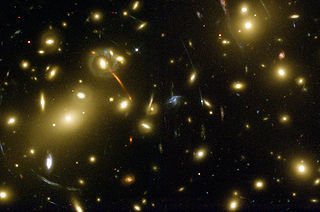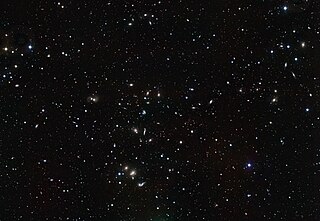Related Research Articles

A supercluster is a large group of smaller galaxy clusters or galaxy groups; they are among the largest known structures in the universe. The Milky Way is part of the Local Group galaxy group, which in turn is part of the Virgo Supercluster, which is part of the Laniakea Supercluster. The large size and low density of superclusters means that they, unlike clusters, expand with the Hubble expansion. The number of superclusters in the observable universe is estimated to be 10 million.

The Virgo Supercluster or the Local Supercluster is a mass concentration of galaxies containing the Virgo Cluster and Local Group, which itself contains the Milky Way and Andromeda galaxies, as well as others. At least 100 galaxy groups and clusters are located within its diameter of 33 megaparsecs. The Virgo SC is one of about 10 million superclusters in the observable universe and is in the Pisces–Cetus Supercluster Complex, a galaxy filament.

Abell 2218 is a large cluster of galaxies over 2 billion light-years away in the constellation Draco.
The Centaurus Cluster (A3526) is a cluster of hundreds of galaxies, located approximately 170 million light-years away in the Centaurus constellation. The brightest member galaxy is the elliptical galaxy NGC 4696 (~11m). The Centaurus cluster shares its supercluster, the Hydra–Centaurus Supercluster, with IC4329 Cluster and Hydra Cluster.

Abell 2029 or A2029 is a large and relaxed cluster of galaxies 315 megaparsecs away in the constellation Virgo. A2029 is a Bautz–Morgan classification type I cluster due to its large central galaxy, IC 1101. Abell 2029 has a diameter of 5.8–8 million light-years. This type of galaxy is called a cD-type brightest cluster galaxy and may have grown to its large size by accreting nearby galaxies. Despite its relaxed state, it is the central member of a large supercluster which shows clear signs of interaction.

The Pavo-Indus Supercluster is a neighboring supercluster located about 60–70 Mpc (196–228 Mly) away in the constellations of Pavo, Indus, and Telescopium. The supercluster contains three main clusters, Abell 3656, Abell 3698, and Abell 3742.

The Hercules Cluster is a cluster of about 200 galaxies some 500 million light-years distant in the constellation Hercules. It is rich in spiral galaxies and shows many interacting galaxies. The cluster is part of the larger Hercules Supercluster, which is itself part of the much larger Great Wall super-structure.

The Hercules Superclusters refers to a set of two nearby superclusters of galaxies.

Abell 2199 is a galaxy cluster in the Abell catalogue featuring the brightest cluster galaxy NGC 6166, a cD galaxy. Abell 2199 is the definition of a Bautz-Morgan type I cluster due to NGC 6166.

Abell 2147 is a galaxy cluster in the Abell catalogue. It is located within the core of the Hercules Superclusters, within Serpens Caput, near the cluster Abell 2152, approximately two degrees south southwest of the Hercules Cluster. It is possible that Abell 2147 is actually part of the Hercules Cluster considering that it shares the same redshift of 550 million light years.
Abell 2061 is a galaxy cluster in the constellation of Corona Borealis. On a larger scale still, Abell 2061, along with Abell 2065, Abell 2067, Abell 2079, Abell 2089, and Abell 2092, make up the Corona Borealis Supercluster. It has a northeast southwest orientation and Abell 2067 lies 1.8 megaparsecs north of it.
Abell 2067 is a galaxy cluster in the constellation of Corona Borealis. On a larger scale, Abell 2067, along with Abell 2061, Abell 2065, Abell 2079, Abell 2089, and Abell 2092, make up the Corona Borealis Supercluster. Abell 2061 lies 1.8 megaparsecs south of it and the two are likely interacting.
Abell 569 is a galaxy cluster in the northern constellation of Lynx. It is organized into two primary condensations that are separated by about 1.5 Mpc, and is probably a member of the Perseus Supercluster. The brightest galaxy in the cluster is NGC 2329, a giant elliptical galaxy of type D that is associated with a radio and X-ray source.
Abell 2152 is a bimodal galaxy cluster and one of three clusters comprising the Hercules Supercluster. It contains 3 BCGs; the S0 lenticular UGC 10204, the pair UGC 10187, and the SA0 unbarred lenticular CGCG 108-083. In total there are 41 galaxies which are confirmed to be members of the cluster. The cluster is classified as a Bautz-Morgan type III and Rood-Sastry class F cluster, indicating morphological irregularity and perhaps dynamical youth. It is receding from the Milky Way galaxy with a velocity of 12385 km/s.

NGC 710 is a spiral galaxy located 260 million light-years away in the constellation Andromeda. It was discovered by the Irish engineer and astronomer Bindon Blood Stoney on October 28, 1850 and is a member of the galaxy cluster Abell 262.

Draco Supercluster (SCL 114) is a galaxy supercluster in the constellation Draco. It is located at a distance of 300 Mpc h−1 on a side of a void of diameter of about 130 Mpc h−1. The near side of the void is bordered by the Ursa Major supercluster. The estimated size of the supercluster reaches 410 million light years and a mass of 1017 M☉, making it one of the largest and most massive superclusters known in the observable universe.

ESO 383-76 is an elongated, X-ray luminous supergiant elliptical galaxy; the dominant and brightest member of the Abell 3571 galaxy cluster. It is located at the distance of 200.6 megaparsecs from Earth, and is possibly a member of the large Shapley Supercluster. With the diameter of about 540.89 kiloparsecs, it is one of the largest galaxies in the local universe, as well as one of the largest galaxies known.
References
- ↑ Einasto, M.; Einasto, J.; Tago, E.; Müller, V.; Andernach, H. (2001). "Optical and X-Ray Clusters as Tracers of the Supercluster-Void Network. I. Superclusters of Abell and X-Ray Clusters". The Astronomical Journal. 122 (5): 2222–2242. arXiv: astro-ph/0012536 . Bibcode:2001AJ....122.2222E. doi:10.1086/323707. S2CID 16129925.
- ↑ Kopylova, F. G.; Kopylov, A. I. (2013). "Investigation of properties of galaxy clusters in the Hercules supercluster region". Astronomy Letters. 39 (1): 1–16. Bibcode:2013AstL...39....1K. doi:10.1134/S1063773712120043. S2CID 120136802.